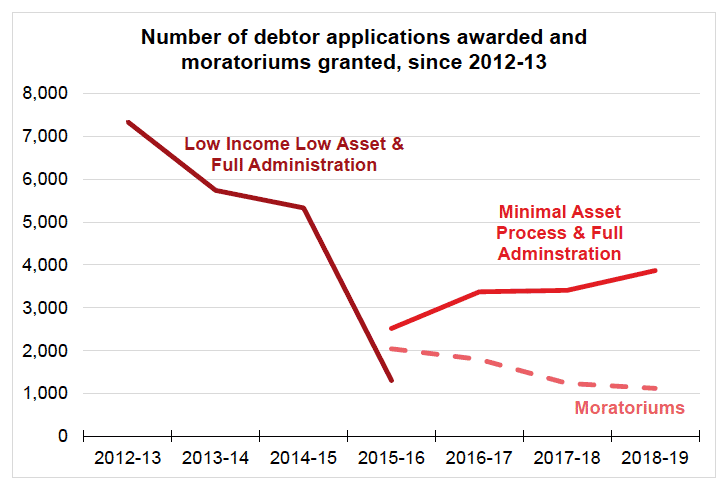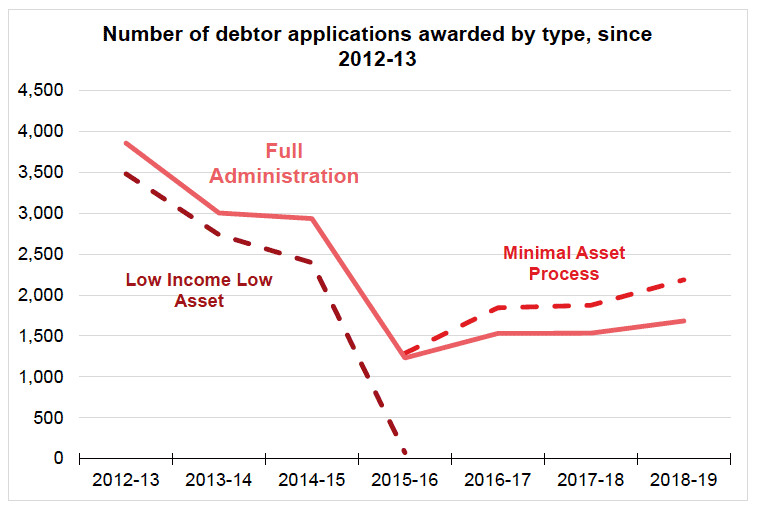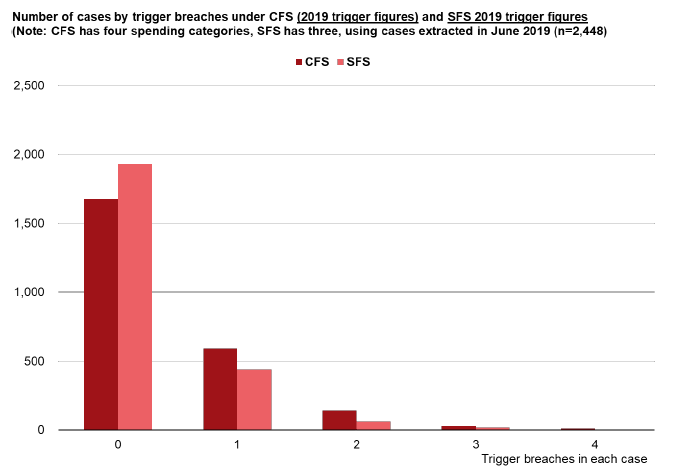Bankruptcy and debt advice review: consultation
The consultation which forms part of the review into the Bankruptcy and Debt Advice (Scotland) Act 2014.
6. Statistical Information
Statistical information has been collated on various aspects of the changes introduced by the Bankruptcy and Debt Advice (Scotland) Act 2014. This information has been organised into either a table or graph to best present the statistical data. The following charts/tables present that data:
Chart 1 presents the trends on Low Income Low Asset and Full Administration in comparison to the Minimal Asset Process and Full Administration from 2012-13 to the present. The chart also shows the trends of Moratorium registrations since their introduction in April 2015.
Chart 2 presents a breakdown of the Low Income Low Asset bankruptcies and the Minimal Asset Process bankruptcy from 2012-13 to the present while showing the Full Administration bankruptcies through that same period of time.
Chart 3 presents a comparison between trigger figure breaches using the Common Financial Statement and the Standard Financial Statement as at June 2019.
Table 1 includes a table which presents a breakdown of the debt levels for Minimal Asset Process bankruptcies for each year since their introduction in April 2015. A second table explores in further detail the number of cases which had debt levels of less than £5,000. This table also presents a breakdown of Full Administration bankruptcies by debt levels for each year since the commencement of the Bankruptcy and Debt Advice (Scotland) Act 2014.
Table 2 breaks down the debt levels for Full Administration bankruptcies which have been assessed as having no contribution fixed.
Table 3 presents the number of cases where a contribution was assessed to be paid per year from 2012/13 to present. Prior to April 2015 contributions were fixed by Income Payment Agreements/Orders and post April 2015 contributions were fixed by Debtor Contribution Orders.
Table 4 presents the number of cases, per year since 2016/17, in which the debtor's discharge was deferred.
Table 5 presents the total number of individuals: referred for the financial education modules; the number of those individuals who accessed the modules; and the number who completed the modules from 2015 to present. The last table presents feedback from those individuals on the benefit of completing the financial education modules.
Chart 1 - Insolvency Activity - Pre and Post 1 April 2015 (including moratorium applications post 1 April 2015)

This chart presents the trends on Low Income Low Asset and Full Administration in comparison to the Minimal Asset Process and Full Administration from 2012-13 to the present. The chart also shows the trends of Moratorium registrations since their introduction in April 2015.
Chart 2 - MAP Bankruptcy Activity v LILA Activity

This chart presents a breakdown of the Low Income Low Asset bankruptcies and the Minimal Asset Process bankruptcy from 2012-13 to the present while showing the Full Administration bankruptcies through that same period of time.
Chart 3 - Updated CFS v SFS Data

Table 1 - MAP debt levels
Number of Minimal Asset Process cases by total debt level due to creditors, since 2015-16
| 2015-16 | 2016-17 | 2017-18 | 2018-19 | |
|---|---|---|---|---|
| £1,500 to less than £5,000 | 168 | 264 | 250 | 275 |
| £5,000 to less than £10,000 | 556 | 811 | 803 | 904 |
| £10,000 to less than £15,000 | 431 | 600 | 670 | 814 |
| £15,000 to less than £17,000 | 126 | 155 | 147 | 189 |
| Total | 1,281 | 1,830 | 1,870 | 2,182 |
Note: Figures presented here may not be consistent with the official, quarterly Scottish Insolvency Statistics publication. These tables are based on data extracted from live databases at a different point in time. The quarterly statistics are the definitive source.
Number of Minimal Asset Process cases by low debt level due to creditors, since 2015-16
| 2015-16 | 2016-17 | 2017-18 | 2018-19 | |
|---|---|---|---|---|
| £1,500 to less than £2,000 | 4 | 4 | 6 | 7 |
| £2,000 to less than £3,000 | 23 | 41 | 50 | 47 |
| £3,000 to less than £4,000 | 60 | 92 | 89 | 77 |
| £4,000 to less than £5,000 | 81 | 127 | 105 | 144 |
| £5,000+ | 1,113 | 1,566 | 1,620 | 1,907 |
| Total | 1,281 | 1,830 | 1,870 | 2,182 |
Note: Figures presented here may not be consistent with the official, quarterly Scottish Insolvency Statistics publication. These tables are based on data extracted from live databases at a different point in time. The quarterly statistics are the definitive source.
Number of Full Administration cases by debt level due to creditors, since 2015-16
| 2015-16 | 2016-17 | 2017-18 | 2018-19 | |
|---|---|---|---|---|
| Less than £17,000 | 235 | 286 | 221 | 238 |
| £17,000 to less than £20,000 | 146 | 190 | 239 | 265 |
| £20,000 to less than £25,000 | 195 | 238 | 266 | 292 |
| £25,000 to less than £30,000 | 95 | 158 | 192 | 219 |
| £30,000 to less than £40,000 | 141 | 210 | 208 | 212 |
| £40,000 to less than £50,000 | 77 | 122 | 113 | 132 |
| £55,000+ | 270 | 340 | 296 | 327 |
| Total | 1,159 | 1,544 | 1,535 | 1,685 |
Note: Figures presented here may not be consistent with the official, quarterly Scottish Insolvency Statistics publication. These tables are based on data extracted from live databases at a different point in time. The quarterly statistics are the definitive source.
Table 2 - Full Administration Bankruptcy with no DCO fixed - Debt levels
Number of Full Administration cases with no Debtor Contribution Order set by debt level due to creditors, since 2015-16
| Count | Percentage | |||||||
|---|---|---|---|---|---|---|---|---|
| 2015-16 | 2016-17 | 2017-18 | 2018-19 | 2015-16 | 2016-17 | 2017-18 | 2018-19 | |
| Less than £17,000 | 145 | 143 | 118 | 146 | 61.7% | 50.0% | 52.7% | 60.8% |
| £17,000 to less than £20,000 | 71 | 49 | 101 | 137 | 48.6% | 25.8% | 42.3% | 51.7% |
| £20,000 to less than £25,000 | 93 | 82 | 109 | 130 | 47.7% | 34.5% | 41.0% | 44.5% |
| £25,000 to less than £30,000 | 47 | 53 | 88 | 119 | 49.5% | 33.5% | 45.8% | 54.3% |
| £30,000 to less than £40,000 | 89 | 75 | 90 | 113 | 63.1% | 35.7% | 43.3% | 53.3% |
| £40,000 to less than £50,000 | 50 | 49 | 53 | 79 | 64.9% | 40.2% | 46.9% | 59.8% |
| £55,000+ | 186 | 197 | 191 | 235 | 68.9% | 57.9% | 64.5% | 71.9% |
| Total | 681 | 648 | 750 | 959 | 58.8% | 42.0% | 48.8% | 56.8% |
Table 3 - Debtor Contribution Levels v IPA Levels
Number of agreed (original) contributions1 by financial year, since 2011-12
| 2011-12 | 2012-13 | 2013-14 | 2014-15 | 2015-16 | 2016-17 | 2017-18 | 2018-19 | |
|---|---|---|---|---|---|---|---|---|
| IPA | 2,131 | 1,762 | 1,549 | 1,267 | - | - | - | - |
| IPO | 2 | 2 | 2 | 1 | - | - | - | - |
| DCO: Full Administration | - | - | - | - | 518 | 591 | 602 | 604 |
| DCO: Creditor Petition | - | - | - | - | 138 | 169 | 210 | 129 |
| All | 2,133 | 1,764 | 1,551 | 1,268 | 518 | 591 | 602 | 604 |
1 Including contributions which are set at more than £0.
Median monthly contribution1 (including variations) where contribution is greater than £0, since 2011-12
| 2011-12 | 2012-13 | 2013-14 | 2014-15 | 2015-16 | 2016-17 | 2017-18 | 2018-19 | |
|---|---|---|---|---|---|---|---|---|
| IPA | 120 | 100 | 100 | 100 | - | - | - | - |
| IPO | 110 | 290 | 290 | 200 | - | - | - | - |
| DCO2 | - | - | - | - | 110 | 120 | 130 | 130 |
| of which: Full Administration | - | - | - | - | 100 | 110 | 120 | 130 |
| of which: Creditor Petition | - | - | - | - | 200 | 220 | 200 | 190 |
| All | 120 | 100 | 100 | 100 | 110 | 120 | 130 | 130 |
1 Figures rounded to nearest £10.
2 Debtor Contribution Order for Creditor Petitions and Full Administration bankruptcies, where contribution is set at more than £0.
Table 4 - Standard Debtor Discharge v. Discharge Deferred
Number of bankruptcy discharges1 by financial year, since 2016-17
| 2016-17 | 2017-18 | 2018-19 | |
|---|---|---|---|
| Normal discharges | 3,094 | 3,743 | 3,835 |
| Deferred discharges | 71 | 259 | 359 |
| Total discharges | 3,165 | 4,002 | 4,194 |
Note: Figures presented here may not be consistent with the official quarterly Scottish Insolvency Statistics publication. This table is based on data extracted from live live databases at a different point in time. The quarterly statistics are the definitive source.
Table 5 - Financial Education - Referrals and Qualitative Survey Data
Number of AiB referrals for financial education by type of debtor applications, from 2015-16 to present1
| Full Administration and MAP bankruptcies awarded | 13,171 |
|---|---|
| of which AiB trustee | 11,177 |
| Referred for financial education | 1355 |
| Accessed financial education | 863 |
| Completed financial education | 683 |
| Full Administration bankruptcies awarded | 5,978 |
| of which AiB trustee | 3,984 |
| Referred for financial education | 388 |
| Accessed financial education | 296 |
| Completed financial education | 282 |
| MAP bankruptcies awarded | 7,193 |
| Referred for financial education | 967 |
| Accessed financial education | 567 |
| Completed financial education | 401 |
1 Note 2015-16 data is partial and the first full year is 2016-17.
Sources: AIB, Money Advice Scotland
Feedback from users who have completed the financial education modules from April 2018 to present (unless stated otherwise)
- 91% of users rated the module's ease of use as either excellent or very good.
- 82% of users noted an increase in their ability to plan ahead, save and prepare for unexpected costs by an average of 86% after completing the module.
- 85% of users noted an increase in their confidence relating to financial matters, after completing the module.
- Following the module, 97% of users were aware of where to go to access help and advice.
- Following the module, 96% of users intend to change their approach to finances.
Source: Money Advice Scotland
Contact
There is a problem
Thanks for your feedback